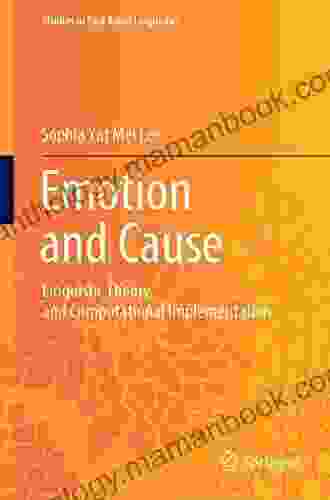Linguistic Theory and Computational Implementation Studies in East Asian Languages: A Comprehensive Exploration of Syntactic Structures, Phonological Systems, and Computational Implementations

5 out of 5
| Language | : | English |
| File size | : | 19295 KB |
| Text-to-Speech | : | Enabled |
| Screen Reader | : | Supported |
| Enhanced typesetting | : | Enabled |
| Print length | : | 190 pages |
The study of East Asian languages has a long and rich history, dating back to the earliest written records of Chinese, Japanese, and Korean. In recent years, there has been a growing interest in the linguistic theory and computational implementation of East Asian languages. This interest is due in part to the increasing globalization of East Asia, which has led to a greater need for communication and understanding between people from different linguistic backgrounds.
East Asian languages are a diverse group of languages, with a wide range of syntactic structures, phonological systems, and writing systems. This diversity presents a number of challenges for linguistic theory and computational implementation. However, it also offers a unique opportunity to study the nature of human language.
Syntactic Structures
The syntactic structures of East Asian languages are quite different from those of Indo-European languages. One of the most striking differences is the use of SOV (subject-object-verb) word order in East Asian languages, as opposed to the SVO (subject-verb-object) word order in Indo-European languages. This difference in word order has a number of implications for the way that East Asian languages are processed and understood.
Another important difference between East Asian languages and Indo-European languages is the use of particles. Particles are grammatical morphemes that are used to mark the grammatical function of words and phrases. East Asian languages have a very large number of particles, which can be difficult for learners to master.
Phonological Systems
The phonological systems of East Asian languages are also quite different from those of Indo-European languages. One of the most striking differences is the use of tones in East Asian languages. Tones are variations in the pitch of the voice that can change the meaning of a word. East Asian languages have a very complex system of tones, which can be difficult for learners to master.
Another important difference between East Asian languages and Indo-European languages is the use of syllable structure. East Asian languages have a very regular syllable structure, which consists of a consonant followed by a vowel. This syllable structure makes East Asian languages easy to pronounce for native speakers, but it can be difficult for learners who are not used to this type of syllable structure.
Computational Implementations
The computational implementation of East Asian languages presents a number of challenges. One of the biggest challenges is the handling of complex characters. East Asian characters are often very complex, and they can be difficult to represent in a computer system.
Another challenge in the computational implementation of East Asian languages is the handling of tones. Tones are an important part of East Asian languages, and they must be represented in a way that allows them to be processed and understood by computers.
Despite these challenges, there has been considerable progress in the computational implementation of East Asian languages in recent years. A number of software programs have been developed that can handle complex characters and tones, and these programs are making it easier for people to communicate and understand each other across linguistic boundaries.
The study of linguistic theory and computational implementation in East Asian languages is a complex and challenging field. However, it is also a fascinating and rewarding field that offers a unique opportunity to study the nature of human language. As the world becomes increasingly globalized, the need for communication and understanding between people from different linguistic backgrounds will only increase. The study of linguistic theory and computational implementation in East Asian languages will play a vital role in meeting this need.
References
* [1] Chao, Y. R. (1968). A grammar of spoken Chinese. Berkeley: University of California Press. * [2] Cheng, C. C. (1973). A synchronic phonology of Mandarin Chinese. The Hague: Mouton. * [3] Li, C. N., & Thompson, S. A. (1981). Mandarin Chinese: A functional reference grammar. Berkeley: University of California Press. * [4] Norman, J. (1988). Chinese. Cambridge: Cambridge University Press. * [5] Ramsey, S. R. (1987). The languages of China. Princeton: Princeton University Press. * [6] Sagart, L. (2002). The Sino-Tibetan languages. London: Routledge.
5 out of 5
| Language | : | English |
| File size | : | 19295 KB |
| Text-to-Speech | : | Enabled |
| Screen Reader | : | Supported |
| Enhanced typesetting | : | Enabled |
| Print length | : | 190 pages |
Do you want to contribute by writing guest posts on this blog?
Please contact us and send us a resume of previous articles that you have written.
 Top Book
Top Book Novel
Novel Fiction
Fiction Nonfiction
Nonfiction Literature
Literature Paperback
Paperback Hardcover
Hardcover E-book
E-book Audiobook
Audiobook Bestseller
Bestseller Classic
Classic Mystery
Mystery Thriller
Thriller Romance
Romance Fantasy
Fantasy Science Fiction
Science Fiction Biography
Biography Memoir
Memoir Autobiography
Autobiography Poetry
Poetry Drama
Drama Historical Fiction
Historical Fiction Self-help
Self-help Young Adult
Young Adult Childrens Books
Childrens Books Graphic Novel
Graphic Novel Anthology
Anthology Series
Series Encyclopedia
Encyclopedia Reference
Reference Guidebook
Guidebook Textbook
Textbook Workbook
Workbook Journal
Journal Diary
Diary Manuscript
Manuscript Folio
Folio Pulp Fiction
Pulp Fiction Short Stories
Short Stories Fairy Tales
Fairy Tales Fables
Fables Mythology
Mythology Philosophy
Philosophy Religion
Religion Spirituality
Spirituality Essays
Essays Critique
Critique Commentary
Commentary Glossary
Glossary Bibliography
Bibliography Index
Index Table of Contents
Table of Contents Preface
Preface Introduction
Introduction Foreword
Foreword Afterword
Afterword Appendices
Appendices Annotations
Annotations Footnotes
Footnotes Epilogue
Epilogue Prologue
Prologue Dix Bruce
Dix Bruce Peter C Brown
Peter C Brown Poornima Manco
Poornima Manco Lucie Brock Broido
Lucie Brock Broido Jessi Klein
Jessi Klein Jack Whyte
Jack Whyte Joosr
Joosr Robert C Allen
Robert C Allen Rohan Bhardwaj
Rohan Bhardwaj Roger Hargreaves
Roger Hargreaves Kelsey Mcknight
Kelsey Mcknight Terry Miles
Terry Miles James Ottar Grundvig
James Ottar Grundvig Erin Nicholas
Erin Nicholas Casey Hill
Casey Hill Marion Zimmer Bradley
Marion Zimmer Bradley N J Bambino
N J Bambino Kindle Edition
Kindle Edition Hayden Thorne
Hayden Thorne Dan Southerland
Dan Southerland
Light bulbAdvertise smarter! Our strategic ad space ensures maximum exposure. Reserve your spot today!

 Bradley DixonA Journey into the Unforeseen: Death in the Silent Places, Unraveling the...
Bradley DixonA Journey into the Unforeseen: Death in the Silent Places, Unraveling the...
 Everett BellThe Unwavering Spirit of Griff Hosker: A Conquistador's Quest for Gold and...
Everett BellThe Unwavering Spirit of Griff Hosker: A Conquistador's Quest for Gold and... Geoffrey BlairFollow ·13.2k
Geoffrey BlairFollow ·13.2k Edwin BlairFollow ·5.9k
Edwin BlairFollow ·5.9k Chandler WardFollow ·8k
Chandler WardFollow ·8k Christian BarnesFollow ·11.8k
Christian BarnesFollow ·11.8k Henry GreenFollow ·17.7k
Henry GreenFollow ·17.7k Aleksandr PushkinFollow ·13.7k
Aleksandr PushkinFollow ·13.7k Federico García LorcaFollow ·12.8k
Federico García LorcaFollow ·12.8k Kirk HayesFollow ·16k
Kirk HayesFollow ·16k

 Vernon Blair
Vernon BlairThe Woman I Met in My Dream: An Unforgettable Night of...
As the veil of night...

 Carlos Fuentes
Carlos FuentesThe Ultimate Guide to Healthy Eating for Toddlers: Meal...
As a parent of a...

 Peter Carter
Peter CarterInside My Autistic Mind: A Journey of Self-Discovery and...
Autism spectrum disorder (ASD) is a...

 Isaac Asimov
Isaac AsimovA Journey Through Jane Austen's Literary Masterpieces:...
Jane Austen, the renowned English...

 Hank Mitchell
Hank MitchellAdvancements in Textiles: Science and Technology by...
The textile...

 Troy Simmons
Troy SimmonsRecovery Road: An Odyssey of Hope and Redemption by...
Recovery Road is a...
5 out of 5
| Language | : | English |
| File size | : | 19295 KB |
| Text-to-Speech | : | Enabled |
| Screen Reader | : | Supported |
| Enhanced typesetting | : | Enabled |
| Print length | : | 190 pages |








